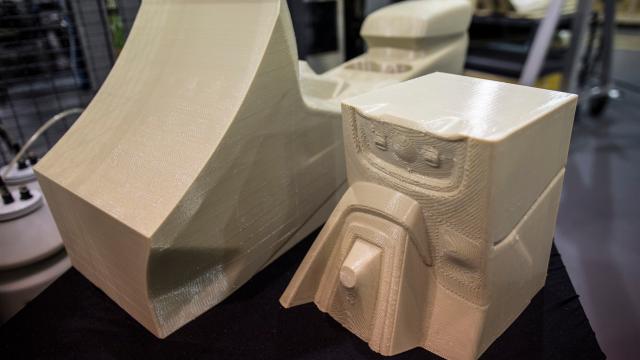Ford Motor Company announced this week that it’s testing 3D printing of large-scale car parts, a move that could eventually lead to the manufacturing of more fuel-efficient vehicles. 3D printing hasn’t really gone large scale like this yet, but the potential upsides are huge.
Photo: Ford
At its research centre in Dearborn, Michigan, Ford said it’s using a 3D printer from Stratasys, a top player in the printing world, to figure out how it can use 3D printing to make large-scale auto parts and components, as the technology is “more cost efficient for production of low-volume parts for prototypes and specialised race car components”.
What does that mean? Well, say the pilot program’s a success, Ford cars of the future might include spoilers that are made by a 3D printer, and could allow for consumers to customise parts throughout vehicles.
[referenced url=”https://gizmodo.com.au/2017/01/this-incredible-sports-car-was-3d-printed-from-laser-melted-metal/” thumb=”https://i.kinja-img.com/gawker-media/image/upload/t_ku-large/tsgjtv9wevd2swyjwzq6.jpg” title=”This Incredible Sports Car Was 3D Printed From Laser-Melted Metal” excerpt=”The hype around consumer 3D printers has mostly died down, but that hasn’t stopped the startup Divergent 3D from barrelling full steam ahead in the industrial printing world. The company debuted the first 3D-printed supercar — the Blade — two years ago and has since continued developing its printing methods. Now, it’s working with major industry players like Peugeot and SLM Solutions to use its printing methods at mass scale.”]
“With Infinite Build technology, we can print large tools, fixtures and components, making us more nimble in design iterations,” said Ellen Lee, Ford technical leader of additive manufacturing research, in a statement.
The idea makes sense. Printing components, tooling and parts instead of relying on traditional methods allows for parts can streamline the process exponentially. As Ford put it:
Using traditional methods to develop, say, a new intake manifold, an engineer would create a computer model of the part, then have to wait months for prototype tooling to be produced. With 3D printing technology, Ford can print the intake manifold in a couple of days, at a significant cost reduction.
The weight of the car could significantly decrease, as well, producing better fuel-efficiency. Ford, for example, said a 3D-printed spoiler could way less than half a cast metal counterpart.
For high-performance niche cars, the opportunity to customise parts thanks to 3D printing could present interesting design choices, too; Frank Stephenson, McLaren’s design chief, told Forbes the automaker uses it for “everything now”.
“Where new product development cycles were 36 months at best when I started, those cycles are now down to 18 months,” Stephenson said. McLaren Racing also recently announced it was partnering with Stratasys to use 3D printing manufacturing for the McLaren-Honda Formula 1 team.
The 3D printing process isn’t currently fast enough to handle high volumes, Ford said, but it will be worth watching to see how this program plays out, as it has the potential to shift how the industry thinks down the line.
